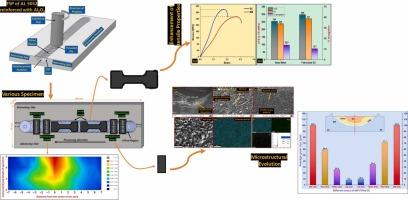Property optimisation of alumina-reinforced aluminium-based surface composites through multi-pass friction stir processing
IF 6.3
2区 材料科学
Q2 CHEMISTRY, PHYSICAL
引用次数: 0
Abstract
With increasing demands for lightweight, high-strength materials in aerospace, automotive, and marine applications, conventional aluminium alloys often require surface modifications to enhance wear resistance and mechanical properties. To address this need, Al2O3-reinforced Aluminium 5052 surface composites (SCs) were fabricated using five-pass friction stir processing (FSP), and their microstructural and mechanical properties were systematically evaluated. Microstructural analysis revealed a remarkable grain refinement, with the average grain size reducing from ∼100 µm in the base metal (BM) to ∼10 µm in the SC due to dynamic recrystallisation induced by FSP. The uniform dispersion of Al2O3 particles further contributed to strengthening mechanisms, leading to a 31 % increase in microhardness, from ∼85 HV in the base alloy to ∼111 HV in the composite. Tensile tests demonstrated substantial improvements, with ultimate tensile strength (UTS) rising by ∼18 % (from ∼254 MPa to ∼298 MPa) and yield strength (YS) increasing by ∼14 % (from ∼238 MPa to ∼271 MPa), while maintaining acceptable ductility. These enhancements are attributed to grain boundary strengthening, Orowan strengthening, and load transfer effects from the Al2O3 reinforcements. The study confirms that multi-pass FSP is an effective technique for developing high-performance aluminium SCs with superior mechanical properties for advanced engineering applications.

多道搅拌摩擦工艺优化铝增强铝基表面复合材料的性能
随着航空航天、汽车和船舶应用对轻质、高强度材料的需求不断增加,传统铝合金通常需要进行表面改性以提高耐磨性和机械性能。为了满足这一需求,采用五道搅拌摩擦工艺(FSP)制备了al2o3增强铝5052表面复合材料(SCs),并对其显微组织和力学性能进行了系统评价。显微组织分析显示,由于FSP诱导的动态再结晶,晶粒细化显著,平均晶粒尺寸从母材(BM)的~100µm减小到SC的~10µm。Al2O3颗粒的均匀分散进一步促进了强化机制,导致显微硬度从基体合金的~85 HV提高到复合材料的~111 HV,提高了31%。拉伸试验表明,在保持可接受的延性的情况下,极限抗拉强度(UTS)提高了~18%(从~254 MPa提高到~298 MPa),屈服强度(YS)提高了~14%(从~238 MPa提高到~271 MPa)。这些增强是由于Al2O3增强的晶界强化、Orowan强化和载荷传递效应。该研究证实,多道次FSP是一种有效的技术,可用于开发具有优越机械性能的高性能铝SCs,用于先进的工程应用。
本文章由计算机程序翻译,如有差异,请以英文原文为准。
求助全文
约1分钟内获得全文
求助全文
来源期刊

Journal of Alloys and Compounds
工程技术-材料科学:综合
CiteScore
11.10
自引率
14.50%
发文量
5146
审稿时长
67 days
期刊介绍:
The Journal of Alloys and Compounds is intended to serve as an international medium for the publication of work on solid materials comprising compounds as well as alloys. Its great strength lies in the diversity of discipline which it encompasses, drawing together results from materials science, solid-state chemistry and physics.
 求助内容:
求助内容: 应助结果提醒方式:
应助结果提醒方式:


